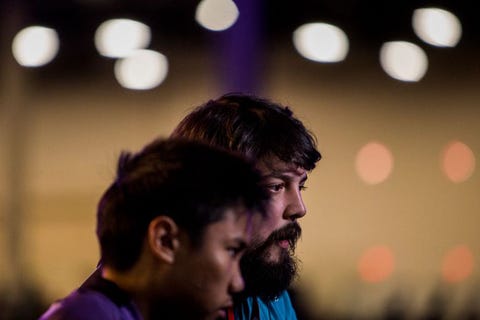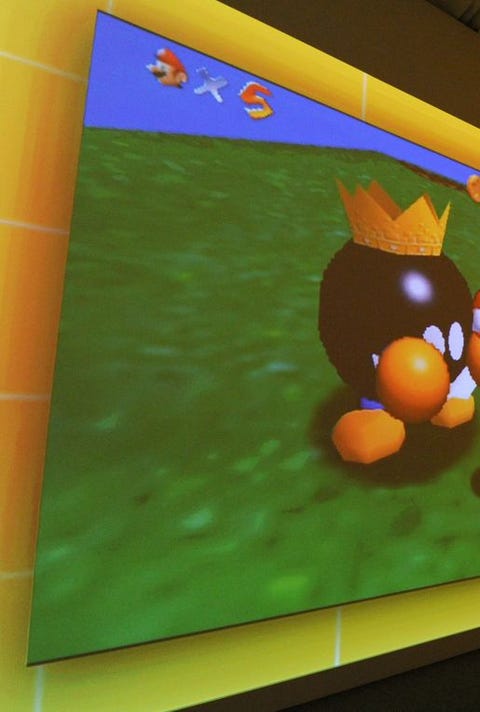Can Esports Keep Your Brain From Aging?
Joseph Marquez’s hands are a blur. His right thumb slides from button to button, his left thumb shifting between angles mere degrees apart on a circumference the size of a quarter’s. He’s just seconds into his Super Smash Bros. Melee contest against Justin McGrath, 25—and this is not going well.
Marquez, 27, is performing 325 actions per minute, or five inputs every second. That requires processing visual information onscreen, reacting, contemplating, strategizing, and executing—all within milliseconds. His fingers slam buttons, unleashing a flurry of moves. But it’s not enough. Marquez, the oldest star left in last August’s Evo 2018 Melee tourney, falls, slipping into the losers bracket.

He doesn’t dwell on that. “I try not to think when I’m playing,” says Marquez, known as Mang0. And that strategy has worked for a decade. He is a star for Team Cloud9, a top squad in the $700 million world of competitive gaming, better known as esports. Marquez entered his first tournament in 2007, won his first national crown a year later, and has been among the best ever since.
But he plays a sport whose players have a short shelf life. Traditional sports stress mind and body, but esports are mostly mental. They challenge your brain, especially its knowledge centers, object-perception hubs, and learning and processing engines. The reaction time and efficiency of these systems begin to diminish naturally in your mid-20s, which may be why esports are dominated by people in their early 20s. That means that Marquez may be nearing game over. Last year, he finished a career-low sixth in the world Melee rankings.
Marquez says he’ll “play as long as my hands allow,” but to do so he’ll have to slow the cognitive-aging process. Emerging science offers hope. With the right training, Marquez, and anyone with a PlayStation, might be able to preserve—or level up—his brain prowess.
Brain Reaction Time Ages . . . Quickly
Age 24. That’s when your brain’s reaction times begin to decline, according to research from Simon Fraser University in British Columbia. Scientists analyzed reaction-time data from 3,305 gamers between the ages of 16 and 44, observing their reactions when playing StarCraft II, a game that has you making a lot of decisions in real time. The researchers scored “looking-doing” latency, how quickly players could spot something unique onscreen and react. A 39-year-old is about 150 milliseconds slower than a similarly skilled 24-year-old. That’s up to 30 seconds of lost reaction time every 15 minutes.
One potential chemical reason for this decline: N-acetylaspartate (NAA), the second-most concentrated amino acid in the central nervous system, begins diminishing. Among NAA’s purported functions is contributing acetate for myelin sheaths, which insulate nerve cells and increase the speed and efficiency at which information travels throughout the brain. This, combined with the shrinkage of the memory-driving frontal lobe and hippocampus, starts the erosion of your ability to store and recall information.
Gaming may offer a workaround for many. Different video games seem to stimulate different parts of the brain. That means your Xbox can provide a brain “workout”—if used correctly. But just as your body can’t thrive on fitness 24/7, your brain needs the right dose of gaming—not round-the-clock Call of Duty. Fighting games, like Super Smash Bros. and Street Fighter, challenge you to accelerate your thought process. Open-world games, like Fortnite and Grand Theft Auto, could prevent age-related volume loss in the hippocampus. Esports science is in its infancy, so both researchers and players are searching for (and disagreeing on) the right mix.
Marquez doesn’t seem interested in the research. Many esports teams believe more practice is better. Marquez’s tourney prep: He plays Super Smash Bros. Melee, a Nintendo GameCube–era game that he also streams online, off and on all day. He’s not changing. “Maybe my reactions are a little slower,” he says. “But put me in a certain situation in the game and I can react to some shit that nobody else can.” His experience may indeed compensate for biological decline, but he may not be optimizing his brain performance, says Mark Campbell, Ph.D., who heads the three-year-old Lero eSports Science Research Lab at the University of Limerick in Ireland.

Getty ImagesCharlie Crowhurst – FIFA
Campbell thinks e-athletes may retire early because they burn out, worn down from relentless (and one-dimensional) training hours. He recommends that players focus on efficiency instead of volume, using intermittent training. In general, people can maintain intense concentration for 15 minutes, he says, so e-athletes should break their “training” into smaller, intensive blocks, rather than just nonstop playing. Think 15 minutes working on controller skills, then 15 minutes strategizing in the heat of the action, then 15 minutes of game play. “The idea is training with a bit of purpose,” he says.
The Best Games For Your Brain
This is worth keeping in mind for everything from your sports prep to your personal brain-honing efforts, and it fits with what neuroscience has taught us about learning in general. Along with focused training, variety may be critical. Different games deliver different cognitive advantages. Marquez, for example, misses out on the benefits for the hippocampus that come with open-world games.
Such games may succeed by pushing you to explore three-dimensional game worlds. One of the earliest video games to do that was Super Mario 64, a 1996 Nintendo 64 game and the subject of a 2014 German study. Researchers had adults play it for at least a half hour daily for two months. They saw brain volume increases in the regions responsible for spatial processing, memory, strategic planning, and motor skills.

Why? Craig Stark, Ph.D., a neurobiology professor at the University of California, Irvine, who studies how video games affect the mind, may have the answer: the “environmental-enrichment effect,” which has been observed in mice. Drop a mouse into a room with toys and places to explore and “wonderful things happen to its ability to learn new information,” he says.
“Immersive, 3-D types of games,” Stark says, make you the mouse. The shining esports example is open-world heavyweight League of Legends. “You have to remember where you are going, where are your resources, and then hold on to all of that information,” Stark says. “People doing League of Legends keep their hippocampi in good shape.” Our brains are wired to learn and retain new information, so you can use environmental enrichment to hone your own. “Navigate around and get back home without that nice little iPhone GPS,” says Stark.
Gaming for Brain Health Is On The Rise
Athletes of more-physical sports are embracing the simulated exploration that gaming offers, too. NFL and NBA athletes utilize NeuroTracker, a virtual–reality-style game that has you track multiple targets across a 3-D space. Virtual performance has been predictive of athletic–performance statistics throughout the season. The military is also making use of virtual–reality flight and fight simulators. NASA uses VR simulations to train for rescues and practice spacewalk procedures. And flipping the script, gamer Jann Mardenborough recently went from being a Gran Turismo 5 champion in 2011 to being a driver on a real motor–racing team. (Yes, really.)
The rise of esports and esports research means more attention for Marquez, who meets his chief rival, Adam “Armada” Lindgren, in that losers bracket. Lindgren, 25, owned his elder in 2017. At Evo 2018, Marquez and his favorite character, Falco, fall to Lindgren again. More age-related slippage? Marquez is defiant. “I really don’t think age matters much,” he says. But Lindgren is burned out. Weeks later, on YouTube, he announces he’s retiring from Smash singles. Still, Marquez, the Atari of his craft, isn’t going anywhere. “You might even be smarter as you get older,” he says.
If you play the right games.
Source: Read Full Article
